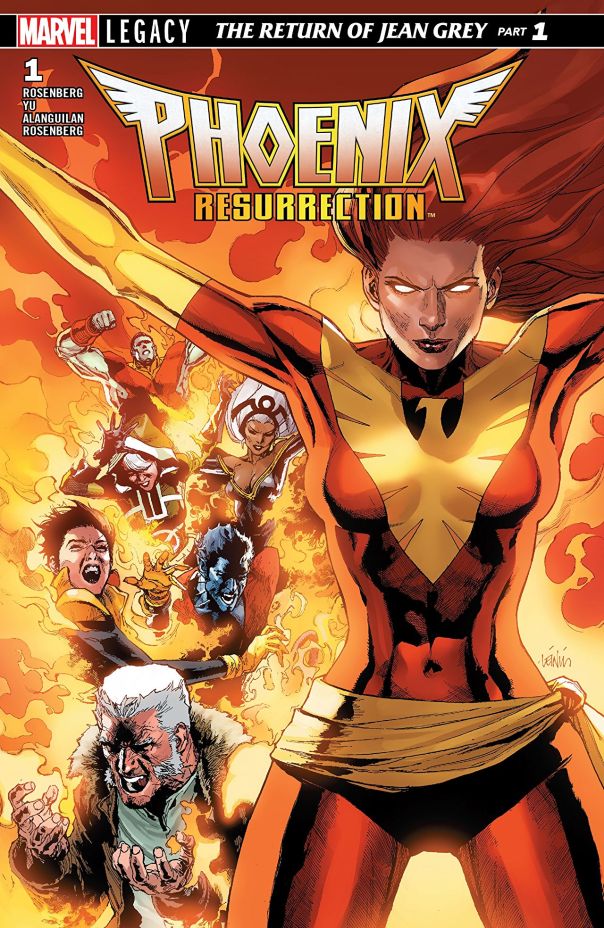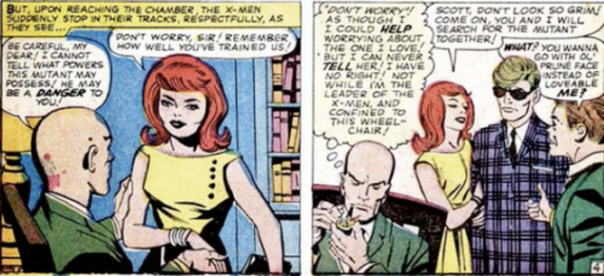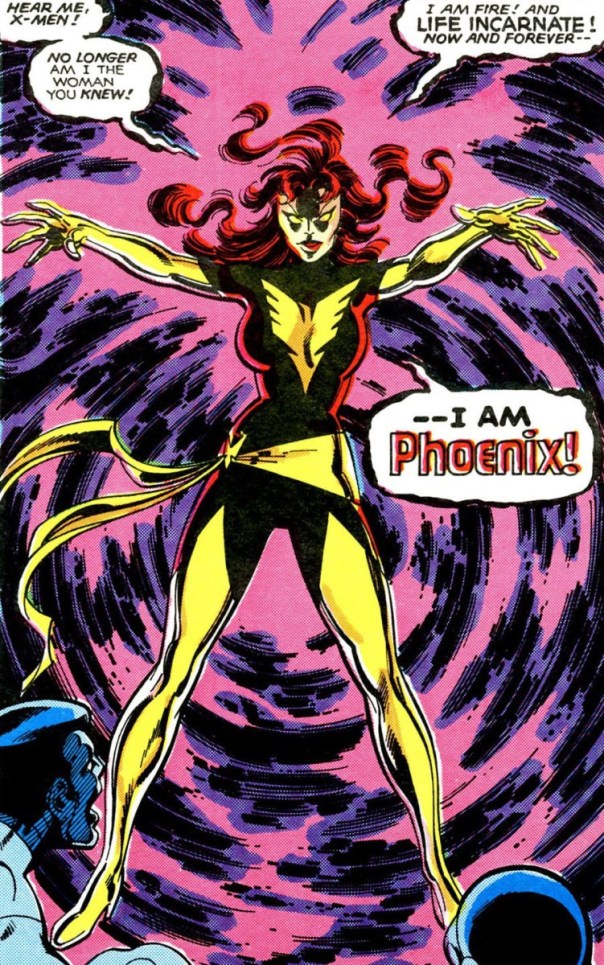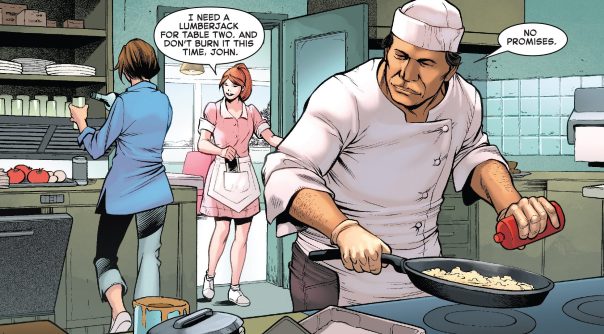Marvel Comics is in the middle of releasing its series Phoenix Resurrection: The Return of Jean Grey. The importance of this story—and of Jean Grey as a character—cannot be overstated. The X-Men franchise has always been known for championing diversity and those whom society has oppressed, marginalized, or misrepresented. And the original character to establish this legacy of representation is Jean Grey.

Why? Jean certainly doesn’t represent the most diverse or marginalized of demographics. She’s white, financially well-off, American, and almost the poster child for heteronormativity. In fact, for a woman who is one of the most powerful forces in the Marvel Universe, she spent a long time being written as just “the girl.”
In an industry where heroics were so often the purview of cis- straight white men, the X-Men franchise offered a place of diversity in the pages of mainstream comics. It gave us strong female characters like Kitty Pryde, Storm, and Danielle Moonstar. The two authority figures leading mutant-kind were Magneto and Charles Xavier, who were supposedly inspired by Malcolm X and Dr. Martin Luther King, Jr. And it cannot be understated that in a time when the Comics Authority forbade open portrayals of anything other than heteronormativity, Chris Claremont offered a voice for LGBTQ+ narratives with the use of queercoding for several characters, which set the precedent for Marvel’s first same-sex marriage to appear in the pages of Astonishing X-Men issue 51.
But before all of that, there was Jean Grey. She was the only girl on a team of men. And, until recent controversial retcons identified founding X-Man Bobby Drake (AKA Iceman) as gay, this made Jean the only member of the original X-Men who wasn’t a straight cis- white American male of middle-to-upperclass origins. Because, in the 60s, whiny suburban teenagers is what passed in mainstream comics for a marginalized group hated and feared by society but still palatable enough to be marketed on newsstands. Like the Invisible Woman in the Fantastic Four or the Wasp in the original Avengers lineup, Jean served a mandatory role as the girl of the team rather than being a fully formed person with a developed personality and backstory of her own.
Worse, as the girl, Jean was often portrayed as the object of others’ desire, rather than a character with agency or desires of her own. The boys fought over who would claim her, and her mentor, Professor X, harbored feelings for her. Of course, many of these problematic tropes can be understood as being simply the narrative conventions of the time, and (like all literary works) must be viewed within the cultural context of that era.

The Silver Age of Comics in which the X-Men were conceived came to its end, and the original team matured. And eventually, as new characters like Storm and Kitty Pryde joined the team, the old ones had to struggle to redefine their roles in the world (both as superhumans and as ordinary people struggling with the typical financial and emotional dramas of the day). Jean might have begun with less personality than the average Barbie, but she grew into an independent woman who asserted herself over her male counterparts, balancing loyalty to her companions with self-interest, and in time, she soon became the most powerful BAMF the X-Men had ever known.
That’s right, I’m talking about the Phoenix.

While flying around on a cosmic mission in space (as one is wont to do in the Marvel Universe), Jean took control of a powerful cosmic entity known as the Phoenix Force. In taking this power into herself, she died, but managed to save the lives of her teammates (among them her love interest, Scott Summers, AKA Cyclops, AKA “Slim”). Apparently, Jean couldn’t be a cosmically empowered being for more than an instant before the editorial glass ceiling fridged her. But for a moment, Jean Grey was the most powerful being in the universe.
Boyfriend Scott got to grieve her, and X-Men moved on to new stories.
But then, Jean came back from the dead, now calling herself the Phoenix. And while this set in motion some of the most iconic stories ever told by Marvel, it also addressed a real issue with her character from the beginning, which is to say that Jean Grey had one of the stupidest superhero names since someone over at DC Comics came up with Arm-Fall-Off-Boy (which is in fact a real thing, because comics).
Jean’s original name on the X-Men, Marvel Girl, sounds a lot more like a gimmicky marketing ploy for Marvel Comics than an actual representation of her powers or personality. Especially when compared to the evocative names of her counterparts Cyclops, Beast, Angel, and Iceman. (Admittedly, Professor X isn’t a great name either, but Marvel Girl literally sounds like an advertisement). She spent a good bit of her time as Marvel Girl overlapping with other superpowered billboards like Captain Marvel, Ms Marvel, and the alien hero Mar-Vell. This is probably why she’s often known simply by her given name. But for a while, she changed her superhero name to “Phoenix,” and this is around the time she began to kick some serious mutant ass.

Ask any group of comics fans to name the greatest X-Men story ever written, and probably half of them will tell you The Dark Phoenix Saga. I’m not going to get into all the reasons it’s a masterpiece here (since doing so would be longer than the rest of this blog combined), but it completely revolutionized both the X-Men series and comic storytelling as a whole. Suffice it to say, by the end of this story, no one would be talking about Jean Grey as “the girl.” They’d talk about her as the great cosmic entity who destroyed worlds, reshaped reality, and transcended the limits of death. Of course, her katabatic exploits meant that Jean would kickstart the trope of superheroes pulling a good ol’-fashioned Nazarethean resurrection every other Sunday.
Since then, Jean would go on to star in number of the great X-Men epics. She battled the evil omega mutant Apocalypse as a member of the X-Factor, married childhood sweetheart and redhead-obsessed Cyclops, and fought the psychic entity called Onslaught (who turned out to be all the repressed evil tendencies of Professor X, including his inappropriate feelings for a young Jean Grey). Jean took part in some of the greatest stories the X-Men ever had, including the Grant Morrison run of New X-Men and Greg Pak’s miniseries Phoenix: Endsong. The legendary Astonishing X-Men run by Joss Whedon dealt with both Wolverine and Cyclops grieving the loss of Jean. And then she was just gone.
After being killed at the end of New X-Men, Whedon’s Astonishing run immediately predicted her return. Which isn’t much to be surprised at, as in one way or another Jean Grey and/or the Phoenix Force replicating her had by this time resurrected a half dozen times.
But Jean didn’t return. When most of the world’s mutants were depowered by the Scarlet Witch, Jean stayed dead. When the original X-Men lineup shared an adventure together during the first superhero Civil War, she was notably still dead. When a magical mutant girl, Hope Summers, appeared and immediately began to alter the fates of mutants and control the Phoenix Force, Jean was absent. And then when she did return, it wasn’t even the Jean everyone knew and loved, but a time-displaced version of the teenage Jean Grey from the first few issues of X-Men.
After more than a decade, Matt Rosenberg is bringing her back in Phoenix Resurrection.

Rosenberg ends the first issue with an Afterword, whose first line reads “I never got to properly mourn Jean Grey.” This truism, one felt by many comic fans, is further explored as he summarizes his experiences with the character, and his expectation that she would just come back one day. Considering the resurrection of dead heroes isn’t only a trope, but one that Jean is more or less responsible for, it feels wrong that it’s taken so long for her to return.
Since Jean’s death at the end of New X-Men, her comrades Wolverine, Angel, and Nightcrawler have died and resurrected, as has Cable (who, in keeping with the convoluted family dynamics of an X-Men story, is the son of Cyclops and a clone of Jean Grey who Cyclops married after the original Jean was dead). Other non-mutant Marvel heroes such as Thor, Captain America, Hawkeye, the Punisher, the original Spider-Man, and the second Ant-Man have similarly pulled the zombie Lazarus routine and sprinted through the afterlife’s revolving doorway.
But Phoenix Resurrection: The Return of Jean Grey is so much more than its oh-so-on-the-nose title would have you believe. And also so much less. It is not a large scale event to the same extent that other major stories featuring the Phoenix have been. As the plot goes, the story is a fairly standard affair, if perhaps a bit more surreal than most.
But in its surrealism we see the value of the story as Rosenberg tells it. This could have been just another apocalypse, any one of a dozen going on simultaneously in different corners of the main Marvel Universe. Instead, the main focus of the story seems to star a teenaged Jean Grey working as a waitress at a 1950s-style diner in middle-of-nowhere suburbia in a hallucinatory sequence as she tries to reassert her grasp of reality.

This sequence evokes some of the worst chauvinist stereotypes of early comics and American culture, a mental prison that Jean appears trapped in. And yet, breaking free of such a prison of conventions is the destiny that took Jean Grey from being “the girl” of the X-Men lineup to the mighty Phoenix she is now.
Many of the other characters seemed crammed into the story to fill out the team line-up of the various X-books, but Kitty Pryde stands out as the X-Men’s current leader, as does the presence of Laura (AKA, the All-New Wolverine), Psylocke, Storm, Rogue, and Rachel Summers, showcasing a cast of strong X-Women who either had close ties to Jean or have character arcs directly impacted by her legacy. Plus, there’s a poignant reveal of Emma Frost reclining in a decadent throne that seems like a moment out of her early supervillainous career, echoing old tensions between the two back in the aforementioned Dark Phoenix Saga.
So, here we have a story with strong characters and a surrealist psychosymbolic mindscape bringing back one of the most important and iconic characters in the Marvel Universe. If the tone of this book is any indication, the shift in focus on Jean Grey and the Phoenix in coming years will be away from her portrayal as either a repressed woman shoved into a gender role, or as an apocalyptically overpowered force of nature. Instead, we might finally get some good stories that focus on her as a person, and allow her to grow in a new direction as an individual.